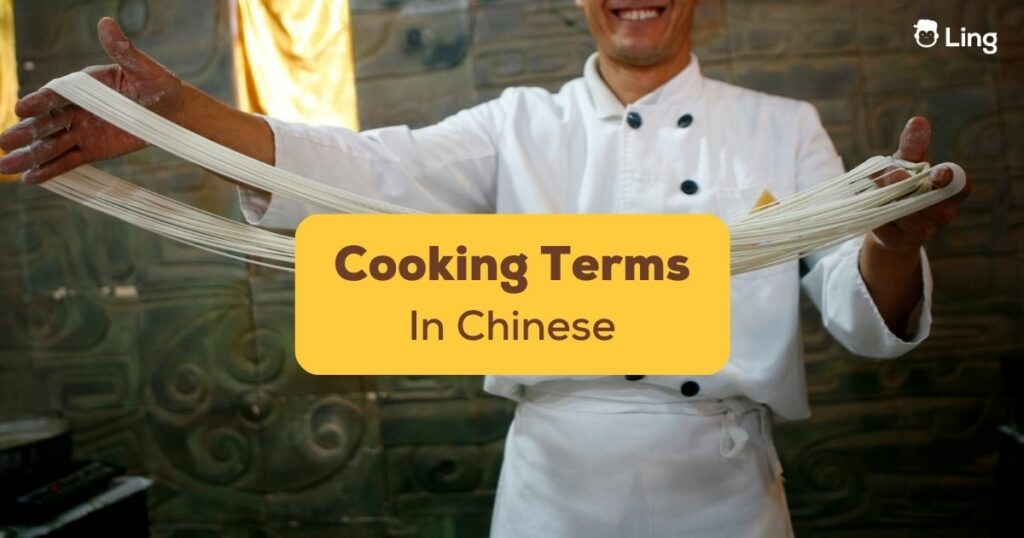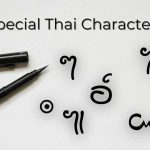Cooking is a big part of Chinese culture. People use food to celebrate holidays, honor guests, and unite people. It’s not just about eating. It’s also about socializing. If you’re interested in learning Chinese and the culture of China, then learning about cooking terms in Chinese might be a great way to get started!
Chinese cuisine is a culinary marvel with unique flavors, textures, and aromas. With over 5,000 years of history and countless regional variations, Chinese cuisine is a true feast for the senses. From the fiery spices of Sichuanese cuisine to the delicate flavors of Cantonese dim sum, each dish is a carefully crafted masterpiece that reflects China’s diverse cultural and geographical influences.
What sets Chinese cuisine apart is its emphasis on the harmony of contrasting flavors thanks to its wide range of ingredients, such as sweet and sour or salty and spicy. Whether it’s crispy Peking duck or steaming bowls of noodles, Chinese cuisine is a timeless culinary tradition that continues to captivate and delight food lovers worldwide.
Cooking Terms In Chinese
Planning to order from a Chinese restaurant? Here are some popular cooking terms in Chinese that we guarantee will help you spice up your kitchen conversation.
Stir-Fry – 炒 (Chǎo)
Stir-fry is a cooking method that’s very popular in China. Literally meaning “to fry,” stir fry involves cooking small pieces of meat and vegetables quickly in a wok over high heat with enough oil to prevent sticking. The main trick is not overcooking your ingredients—you want them to be vibrant and crunchy.
You can see why it’s called stir fry: The ingredients are tossed and cooked quickly! Since this method cooks food quickly and evenly, it’s perfect for fried rice, chop suey (stir-fried vegetables), and chao mein (stir-fried noodles).
While stir-frying may seem like an easy way to make meals, it does require some practice because it takes time to get good at stirring techniques.
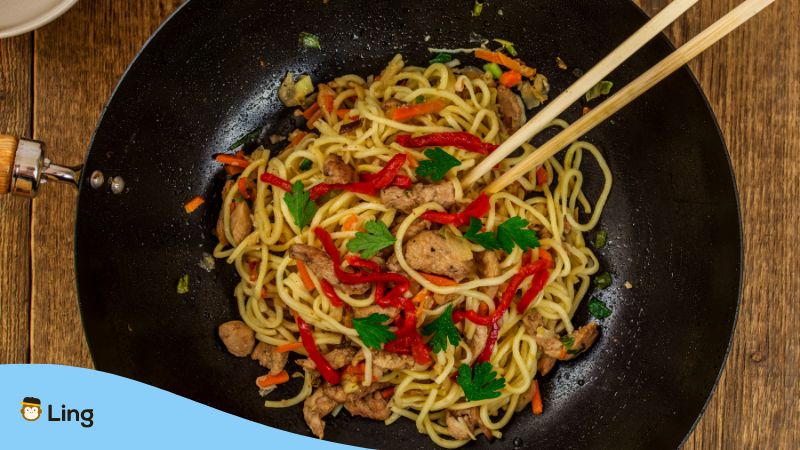
Deep fry – 炸 (Zhà)
Deep fry is a cooking technique that involves cooking over prolonged heat with ingredients wholly immersed in oil. The result? Crispy, delicious goodness! This technique is commonly used in Chinese cuisine and other Asian cuisines. Deep frying is also a popular way to prepare many Chinese foods like Crispy Fried Chicken Legs 酥炸鸡腿 (Sū zhà jī tuǐ).
You usually use a wok or saucepan with high sides when deep frying something, so the oil doesn’t splatter everywhere when your food starts sizzling! Remember, the food should also be completely immersed in the oil. So you might need to use a ladle or spoon to move the food around so that it is fully submerged.
Fun Language Fact: The word 炸 (zhà) means “fried in oil” or “deep-fried food.” You can use 炸 (zhà) not only for cooking but also for describing something fried.
Roast – 烤 (Kǎo)
When you think of Chinese cooking, you may think of Peking Duck. This Chinese roast duck is probably one of the most famous dishes in the world, and it’s also one of the tastiest. It’s typical street food in China, and you can find it anywhere.
If you’re a foodie, you’ll know that roasting is one of the essential cooking techniques out there. It’s a great way to bring out the flavor in your favorite dishes and make them even more delicious.
Roasting is called 烤 (Kǎo) in Chinese. This method involves cooking food in an oven or an open flame of charcoal, typically at high temperatures. Roasting can be done in many ways and is commonly used for meat and vegetables.

Braise – 烧 (Shāo)
You might be familiar with braising from your kitchen at home, especially if you cook many Asian dishes. But did you know that the Chinese word for braise or 烧 (Shāo) means “to burn?” But don’t be confused!
Braising describes a cooking method where meat or vegetables are covered in liquid, heated in a pan, and then cooked on low heat for an extended period. This method allows the meat or vegetables to cook slowly and absorb all the flavors of their sauce.
Steam – 蒸 (Zhēng)
In China, steaming is called 蒸 (zhēng), one of the most popular cooking methods. It involves placing food in a steamer basket over boiling water. It’s usually used for foods like dumplings or buns. The steam from this cooking method gives food its signature light, fluffy texture.
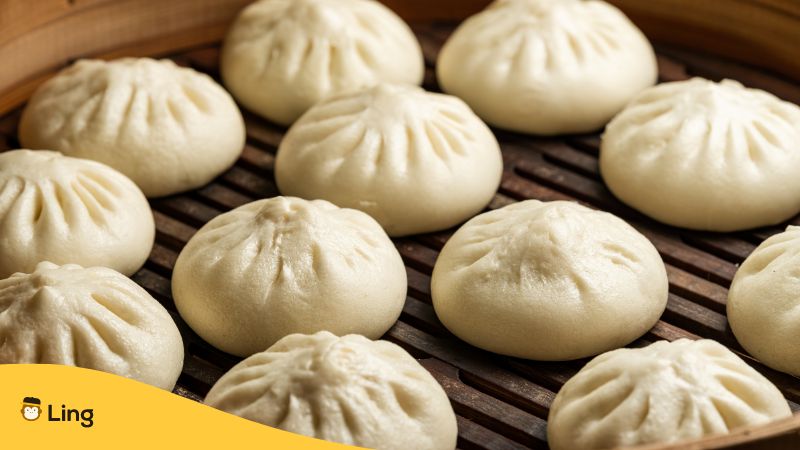
Uniquely Chinese Methods For Cooking
While it’s relatively easy to find recipes that use the same terms you’d use in American cooking, there are specific unique Chinese cooking techniques that you’ll need to learn to make your dishes genuinely authentic.
Here are a few of our favorites:
Red-Cooking – 红烧 (Hóngshāo)
Red cooking, or 红烧 (hóngshāo), is a unique Chinese cooking technique that involves boiling certain ingredients in a soy sauce-based broth. The process is used to tenderize meat and fish and flavor the dishes. It can also cook vegetables, but this is less common. Moreover, it’s one of China’s most common ways to cook beef.
Double Boil – 炖 (Dùn)
Double boil (炖– dùn) is a cooking method unique to Chinese cuisine. It’s a cooking method that involves placing the ingredients in an unglazed ceramic casserole and then placing it on top of another pot filled with boiling water. Additionally, this technique is used for cooking delicate and light dishes, like the Chinese bird’s nest soup.
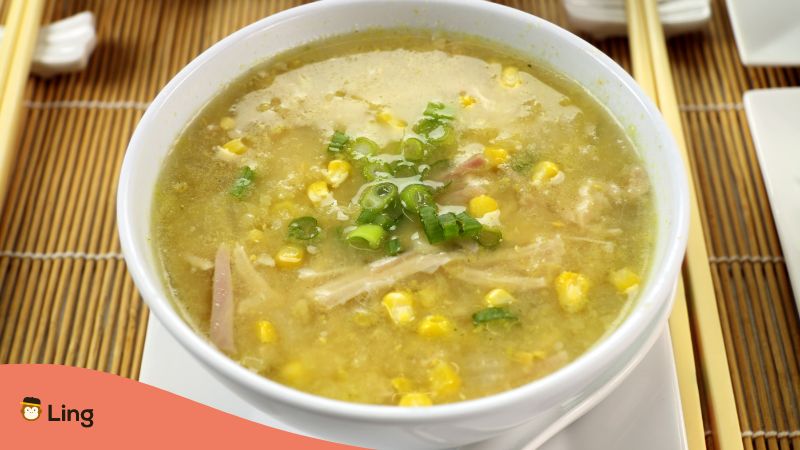
High Heat Stir-Fry – 爆 (Bào)
Some Chinese cooking techniques are more challenging to master, but high-heat stir-frying is one of the most interesting. This technique is called 爆 (bào) in Chinese, which literally means “explosion” or “bursting.”
It involves cooking food at very high heat, typically in a wok, which results in a crispy texture. The idea behind this method is not only to cook the food quickly but also to create a certain “crunchiness” to it.
Stewing – 焖 (Mèn)
Stewing in Chinese cooking combines stir-frying techniques with long, slow cooking. In this method, ingredients are stir-fried until partially cooked. Then the food is transferred to a clay pot for slow cooking in low heat.
This is very different from the Western style of stewing, which involves simmering ingredients in liquid over low heat for an extended period of time. The Chinese stewing method is a great way to prepare tough cuts of meat or vegetables. It tenderizes them by breaking down their fibers and making them easier to chew.
Other Important Cooking Terms In Chinese
In Chinese cooking, there are many other terms you should know. Some are used frequently in recipes, while others are only used occasionally. So, if you want to master Chinese cooking, you must learn the following terms:
| English | Chinese | Pinyin | Sound |
| Bake | 烘 | Hōng | |
| Chop | 斩 | Zhǎn | |
| Cut | 切 | Qiè | |
| Dressing | 拌 | Bàn | |
| Marinating/pickling | 腌 | Yān | |
| Mince | 剁碎 | Duò suì | |
| Pan-fry | 煎 | Jiān | |
| Peel | 剥 | Bō | |
| Slice | 切片 | Qiē piàn | |
| Smoke | 熏 | Xūn |
Cook Chinese Food Like A Pro
There are many more cooking terms in Chinese than we could cover in this article, but we hope these will get you started on your journey to becoming a master chef.
And, even if you’re not planning to cook Chinese food, there are plenty of other reasons to learn more about Chinese food and cooking terms. Not only is it fun and delicious, but it also helps you understand Chinese culture better. If you want to learn more about the Chinese language, check out Ling!

Learn Chinese With Ling
If you’re interested in learning Chinese but don’t know where to start, you’re in luck! The Ling app is a great place to begin your journey. Ling is a language-learning app that helps you learn the basics of Chinese in no time. It’s like having a tutor in your pocket, helping you learn the words you need to know for travel or even just for fun. Want to try it out? Download the Ling app for iOS and Android for FREE today!
